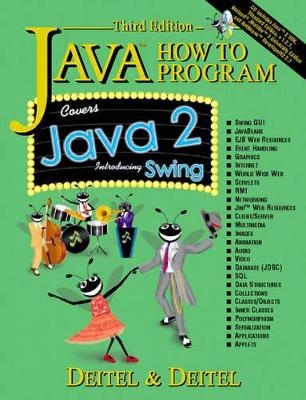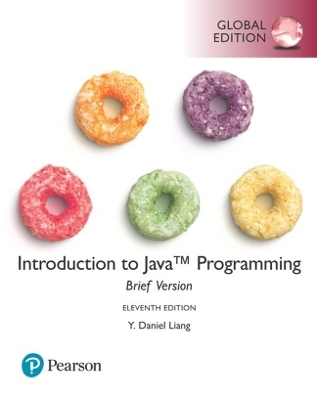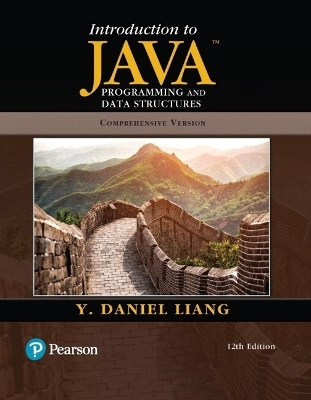
Java How to Program
Pearson
978-0-13-012507-1 (ISBN)
- Titel erscheint in neuer Auflage
- Artikel merken
For CS1 and other courses on programming in Java.
Written by the authors of the world's best-selling introductory C and C++ texts, this state-of-the-art guide examines one of today's hottest computer languages—Java; the first general-purpose, object-oriented language that is truly platform-independent. The latest Java 2 features are incorporated throughout this edition.
HARVEY AND PAUL DEITEL are the principals of Deitel & Associates, Inc., the internationally-recognized training and consulting organization specializing in Java, C++, C, Visual Basic®, object technology, and Internet and World Wide Web programming training. They are also the authors of many best-selling textbooks including C++ How to Program, C How to Program, Visual Basic 6 How to Program and Internet and World Wide Web How to Program.
1. Introduction to Computers, the Internet and the Web
Introduction. What Is a Computer? Computer Organization. Evolution of Operating Systems. Personal, Distributed and Client/Server Computing. Machine Languages, Assembly Languages and High-Level Languages. History of C++. History of Java. Java Class Libraries. Other High-level Languages. Structured Programming. The Internet and the World Wide Web. Basics of a Typical Java Environment. General Notes about Java and This Book. A Tour of the Book.
2. Introduction to Java Applications.
Introduction. A Simple Program: Printing a Line of Text. Another Java Application: Adding Integers. Memory Concepts. Arithmetic. Decision Making: Equality and Relational Operators.
3. Introduction to Java Applets.
Introduction. Thinking About Objects. Sample Applets from the Java 2 Software Development Kit. A Simple Java Applet: Drawing a String. Two More Simple Applets: Drawing Strings and Lines. Another Java Applet: Adding Integers. Java Applet Internet and World Wide Web Resources.
4. Control Structures: Part 1.
Introduction. Algorithms. Pseudocode. Control Structures. The if Selection Structure. The if/else Selection Structure. The While Repetition Structure. Formulating Algorithms: Case Study 1 (Counter-Controlled Repetition). Formulating Algorithms with Top-Down, Stepwise Refinement: Case Study 2 (Sentinel-Controlled Repetition). Formulating Algorithms with Top-Down, Stepwise Refinement: Case Study 3 (Nested Control Structures). Assignment Operators. Increment and Decrement Operators. Primitive Data Types.
5. Control Structures: Part 2.
Introduction. Essentials of Counter-Controlled Repetition. The for Repetition Structure. Examples Using the for Structure. The switch Multiple-Selection Structure. The Do/While Repetition Structure. The break and continue Statements. The Labeled break and continue Statements. Logical Operators. Structured Programming Summary.
6. Methods.
Introduction. Program Modules in Java. Math Class Methods. Methods. Method Definitions. Java API Packages. Random Number Generation. Example: A Game of Chance. Duration of Identifiers. Scope Rules. Recursion. Example Using Recursion: The Fibonacci Series. Recursion vs. Iteration. Method Overloading. Methods of Class JApplet.
7. Arrays.
Introduction. Arrays. Declaring and Allocating Arrays. Examples Using Arrays. References and Reference Parameters. Passing Arrays to Methods. Sorting Arrays. Searching Arrays: Linear Search and Binary Search. Multiple-Subscripted Arrays.
8. Object-Based Programming.
Introduction. Implementing a Time Abstract Data Type with a Class. Class Scope. Controlling Access to Members. Creating Packages. Initializing Class Objects: Constructors. Using Overloaded Constructors. Using Set and Get Methods. Software Reusability. Final Instance Variables. Composition: Objects as Instance Variables of Other Classes. Package Access. Using the This Reference. Finalizers. Static Class Members. Data Abstraction and Information Hiding.
9. Object-Oriented Programming.
Introduction. Superclasses and Subclasses. Protected Members. Relationship between Superclass Objects and Subclass Objects. Constructors and Finalizers in Subclasses. Implicit Subclass-Object-to-Superclass-Object Conversion. Software Engineering with Inheritance. Composition vs. Inheritance. Case Study: Point, Circle, Cylinder. Introduction to Polymorphism. Type Fields and Switch Statements. Dynamic Method Binding. Final Methods and Classes. Abstract Superclasses and Concrete Classes. Polymorphism Examples. Case Study: A Payroll System Using Polymorphism. New Classes and Dynamic Binding. Case Study: Inheriting Interface and Implementation. Case Study: Creating and Using Interfaces. Inner Class Definitions. Notes on Inner Class Definitions. Type-Wrapper Classes for Primitive Types.
10. Strings and Characters.
Introduction. Fundamentals of Characters and Strings. String Constructors. String Methods Length, charAt and getChars. Comparing Strings. String Method hashCode. Locating Characters and Substrings in Strings. Extracting Substrings from Strings. Concatenating Strings. Miscellaneous String Methods. Using String Method valueOf. String Method Intern. StringBuffer Class. StringBuffer Constructors. StringBuffer Methods Length, Capacity. setLength and ensureCapacity. StringBuffer Methods charAt, setCharAt, getChars and Reverse. StringBuffer Append Methods. StringBuffer Insertion and Deletion Methods. Character Class Examples. Class StringTokenizer. A Card Shuffling and Dealing Simulation.
11. Graphics and Java2D.
Introduction. Graphics Contexts and Graphics Objects. Color Control. Font Control. Drawing Lines, Rectangles and Ovals. Drawing Arcs. Drawing Polygons and Polylines. The Java2D API. Java2D Shapes.
12. Basic Graphical User Interface Components.
Introduction. Swing Overview. Jlabel. Event Handling Model. JtextField and JpasswordField. Jbutton. JcheckBox and JradioButton. JcomboBox. Jlist. Multiple-Selection Lists. Mouse Event Handling. Adapter Classes. Keyboard Event Handling. Layout Managers. Panels.
13. Advanced Graphical User Interface Components.
Introduction. JtextArea. Creating a Customized Subclass of Jpanel. Creating a Self-Contained Subclass of Jpanel. Jslider. Windows. Designing Programs that Execute as Applets or Applications. Using Menus with Frames. Using JpopupMenus. Pluggable Look-and-Feel. Using JdesktopPane and JinternalFrame. Layout Managers. BoxLayout Layout Manager. CardLayout Layout Manager. GridBagLayout Layout Manager. GridBagConstraints Constants RELATIVE and REMAINDER.
14. Exception Handling.
Introduction. When Exception Handling Should Be Used. Other Error Handling Techniques. The Basics of Java Exception Handling. An Exception Handling Example: Divide by Zero. Try Blocks. Throwing an Exception. Catching an Exception. Rethrowing an Exception. Throws Clause. Constructors, Finalizers and Exception Handling. Exceptions and Inheritance. Finally Block. Using printStackTrace and getMessage.
15. Multithreading.
Introduction. Class Thread: An Overview of the Thread Methods. Thread States: Life Cycle of a Thread. Thread Priorities and Thread Scheduling. Thread Synchronization. Producer/Consumer Relationship without Thread Synchronization. Producer/Consumer Relationship with Thread Synchronization. Producer/Consumer Relationship: The Circular Buffer. Daemon Threads. Runnable Interface. Thread Groups.
16. Multimedia: Images, Animation, Audio and Video.
Introduction. Downloading the Java Media Framework. Loading, Displaying and Scaling Images. Loading and Playing Audio Clips. The Java Media Player. Animating a Series of Images. Animation Issues. Customizing Applets via the HTML param Tag. Image Maps. Java Plug-In. Internet and World Wide Web Resources.
17. Files and Streams.
Introduction. Data Hierarchy. Files and Streams. Creating a Sequential-Access File. Reading Data from a Sequential-Access File. Updating Sequential-Access Files. Random-Access Files. Creating a Random-Access File. Writing Data Randomly to a Random-Access File. Reading Data Sequentially from a Random-Access File. Example: A Transaction-Processing Program. Class File.
18. Java Database Connectivity (JDBC).
Introduction. Database Systems. Relational Database Model. Relational Database Overview: The Books.mdb Database. Structured Query Language. A First Example. Reading, Inserting, and Updating a Microsoft Access database. Transaction Processing.
19. Servlets.
Introduction. Overview of Servlet Technology. Downloading the Java Servlet Development Kit. Handling HTTP GET Requests. Handling HTTP POST Requests. Session Tracking. Multitier Applications: Using JDBC from a Servlet. Electronic Commerce. Servlet Internet and World Wide Web Resources.
20. Remote Method Invocation (RMI).
Introduction. Case Study: Creating a Distributed System with RMI. Defining the Remote Interface. Implementing the Remote Interface. Define the Client. Compile and Execute the Server and the Client.
21. Networking.
Introduction. Manipulating URLs. Reading a File on a Web Server. Establishing a Simple Server (Using Stream Sockets). Establishing a Simple Client (Using Stream Sockets). Client/Server Interaction with Stream Socket Connections. Connectionless Client/Server Interaction with Datagrams. Client/Server Tic-Tac-Toe Using a Multithreaded Server. Security and the Network.
22. Data Structures.
Introduction. Self-Referential Classes. Dynamic Memory Allocation. Linked Lists. Stacks. Queues. Trees.
23. Java Utilities Package and Bit Manipulation.
Introduction. Vector Class and Enumeratio Interface. Stack Class. Dictionary Class. Hashtable Class. Properties Class. Random Class. Bit Manipulation and the Bitwise Operators. BitSet Class.
24. Collections.
Introduction. Overview. Class Arrays. Interface Collection and Class Collections. Lists. Algorithms. Sets. Maps. Synchronization Wrappers. Unmodifiable Wrappers. Abstract Implementations.
25. JavaBeans.
Introduction. BeanBox Overview. Preparing a Class to Be a JavaBean. Creating a JavaBean: Java Archive Files and the jar Utility. Adding Beans to the BeanBox. Connecting Beans with Events in the BeanBox. Adding Properties to a JavaBean. Creating a JavaBean with a Bound Property. Specifying the BeanInfo Class for a JavaBean. JavaBeans World Wide Web Resources.
Appendix A: Demos.
Introduction. The Sites.
Appendix B: Java Resources.
Introduction. Resources. Products. FAQs. Tutorials. Magazines. Java Applets. Multimedia. Servlets. JavaBeans. Java CORBA. Newsgroups.
Appendix C: Operator Precedence Chart.
Appendix D: ASCII Character Set.
Appendix E: Number Systems.
Introduction. Abbreviating Binary Numbers as Octal Numbers and Hexadecimal Numbers. Converting Octal Numbers and Hexadecimal Numbers to Binary Numbers. Converting from Binary, Octal, or Hexadecimal to Decimal. Converting from Decimal to Binary, Octal, or Hexadecimal. Negative Binary Numbers: Two's Complement Notation.
Appendix F: Object-Oriented Elevator Simulator.
Introduction. Problem Statement. Elevator Laboratory Assignment 1. Elevator Laboratory Assignment 2. Elevator Laboratory Assignment 3. Elevator Laboratory Assignment 4. Elevator Laboratory Assignment 5. Elevator Laboratory Assignment 6. Elevator Laboratory Assignment 7. Elevator Laboratory Assignment 8. Elevator Laboratory Assignment 9. Elevator Laboratory Assignment 10. Elevator Laboratory Assignment 11. Elevator Laboratory Assignment 12. Design Review Questions. Recommended Modifications.
Appendix G: Creating HTML Documentation with javadoc.
Introduction. Documentation Comments. Documenting Java Source Code. javadoc. Files Produced by javadoc.
Appendix H: Enterprise JavaBeans (EJB) Web Resources.
Introduction. Tutorials. Demos. Resources. Developers. Specifications. Frequently Asked Questions (FAQs). Magazines.
Appendix I: Jini Web Resources.
Introduction. Tutorials. Resources. Demos. Specifications. FAQs. Magazines.
Bibliography.
Index.
| Sprache | englisch |
|---|---|
| Maße | 177 x 232 mm |
| Gewicht | 2017 g |
| Themenwelt | Informatik ► Programmiersprachen / -werkzeuge ► Java |
| Mathematik / Informatik ► Informatik ► Web / Internet | |
| ISBN-10 | 0-13-012507-5 / 0130125075 |
| ISBN-13 | 978-0-13-012507-1 / 9780130125071 |
| Zustand | Neuware |
| Informationen gemäß Produktsicherheitsverordnung (GPSR) | |
| Haben Sie eine Frage zum Produkt? |
aus dem Bereich


